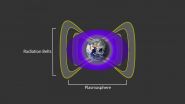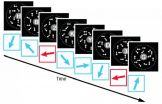(Press-News.org) A team led by the University of Colorado Boulder has discovered an invisible shield some 7,200 miles above Earth that blocks so-called "killer electrons," which whip around the planet at near-light speed and have been known to threaten astronauts, fry satellites and degrade space systems during intense solar storms.
The barrier to the particle motion was discovered in the Van Allen radiation belts, two doughnut-shaped rings above Earth that are filled with high-energy electrons and protons, said Distinguished Professor Daniel Baker, director of CU-Boulder's Laboratory for Atmospheric and Space Physics (LASP). Held in place by Earth's magnetic field, the Van Allen radiation belts periodically swell and shrink in response to incoming energy disturbances from the sun.
As the first significant discovery of the space age, the Van Allen radiation belts were detected in 1958 by Professor James Van Allen and his team at the University of Iowa and were found to be comprised of an inner and outer belt extending up to 25,000 miles above Earth's surface. In 2013, Baker -- who received his doctorate under Van Allen -- led a team that used the twin Van Allen Probes launched by NASA in 2012 to discover a third, transient "storage ring" between the inner and outer Van Allen radiation belts that seems to come and go with the intensity of space weather.
The latest mystery revolves around an "extremely sharp" boundary at the inner edge of the outer belt at roughly 7,200 miles in altitude that appears to block the ultrafast electrons from breeching the shield and moving deeper towards Earth's atmosphere.
"It's almost like theses electrons are running into a glass wall in space," said Baker, the study's lead author. "Somewhat like the shields created by force fields on Star Trek that were used to repel alien weapons, we are seeing an invisible shield blocking these electrons. It's an extremely puzzling phenomenon."
A paper on the subject was published in the Nov. 27 issue of Nature.
The team originally thought the highly charged electrons, which are looping around Earth at more than 100,000 miles per second, would slowly drift downward into the upper atmosphere and gradually be wiped out by interactions with air molecules. But the impenetrable barrier seen by the twin Van Allen belt spacecraft stops the electrons before they get that far, said Baker.
The group looked at a number of scenarios that could create and maintain such a barrier. The team wondered if it might have to do with Earth's magnetic field lines, which trap and control protons and electrons, bouncing them between Earth's poles like beads on a string. The also looked at whether radio signals from human transmitters on Earth could be scattering the charged electrons at the barrier, preventing their downward motion. Neither explanation held scientific water, Baker said.
"Nature abhors strong gradients and generally finds ways to smooth them out, so we would expect some of the relativistic electrons to move inward and some outward," said Baker. "It's not obvious how the slow, gradual processes that should be involved in motion of these particles can conspire to create such a sharp, persistent boundary at this location in space."
Another scenario is that the giant cloud of cold, electrically charged gas called the plasmasphere, which begins about 600 miles above Earth and stretches thousands of miles into the outer Van Allen belt, is scattering the electrons at the boundary with low frequency, electromagnetic waves that create a plasmapheric "hiss," said Baker. The hiss sounds like white noise when played over a speaker, he said.
While Baker said plasmaspheric hiss may play a role in the puzzling space barrier, he believes there is more to the story. "I think the key here is to keep observing the region in exquisite detail, which we can do because of the powerful instruments on the Van Allen probes. If the sun really blasts the Earth's magnetosphere with a coronal mass ejection (CME), I suspect it will breach the shield for a period of time," said Baker, also a faculty member in the astrophysical and planetary sciences department.
"It's like looking at the phenomenon with new eyes, with a new set of instrumentation, which give us the detail to say, 'Yes, there is this hard, fast boundary,'" said John Foster, associate director of MIT's Haystack Observatory and a study co-author.
INFORMATION:
Other CU-Boulder study co-authors included Allison Jaynes, Vaughn Hoxie, Xinlin Li, Quintin Schiller, Lauren Blum and David Malaspina. Other co-authors were from UCLA, Aerospace Corp. Space Sciences Lab in Los Angeles, the University of Minnesota, NASA's Goddard Space Flight Center in Greenbelt, Maryland, the University of Iowa and the New Jersey Institute of Technology.
CU-Boulder is playing a prominent role in NASA's Van Allen Probes mission, which consists of two spinning, octagonal spacecraft weighing 1,500 pounds each. LASP developed the Relativistic Electron Proton Telescope, (REPT) to measure high-energy electrons. LASP also developed the "brains" of the Electronic Field and Waves package to compress huge amounts of mission data to send back to Earth. CU-Boulder will receive roughly $18 million from NASA over the lifetime of the mission.
About a dozen graduate students are participating in the mission, as well as more than a dozen other LASP personnel.
The Van Allen probes mission is part of NASA's Living with a Star Program managed by the Goddard Space Flight Center. The Johns Hopkins University Applied Physics Laboratory built the twin satellites and is managing the mission for NASA.
For more information on LASP visit http://lasp.colorado.edu/home/. For more information on the Van Allen Probes mission visit http://lasp.colorado.edu/home/missions-projects/quick-facts-rbsp/
In the near future, physicians may treat some cancer patients with personalized vaccines that spur their immune systems to attack malignant tumors. New research led by scientists at Washington University School of Medicine in St. Louis has brought the approach one step closer to reality.
Like flu vaccines, cancer vaccines in development are designed to alert the immune system to be on the lookout for dangerous invaders. But instead of preparing the immune system for potential pathogen attacks, the vaccines will help key immune cells recognize the unique features of cancer ...
LOS ANGELES - November 26, 2014 - Work supported by the Stand Up To Cancer (SU2C) - Cancer Research Institute (CRI) - Immunology Translational Research Dream Team, launched in 2012 to focus on how the patient's own immune system can be harnessed to treat some cancers have pioneered an approach to predict why advanced melanoma patients respond to a new life-saving melanoma drug. This new drug, pembrolizumab (Keytruda), was recently approved by the FDA. These findings are reported in Nature online November 26, 2014, ahead of print in the journal.
Over a two-year study, ...
High above Earth's atmosphere, electrons whiz past at close to the speed of light. Such ultrarelativistic electrons, which make up the outer band of the Van Allen radiation belt, can streak around the planet in a mere five minutes, bombarding anything in their path. Exposure to such high-energy radiation can wreak havoc on satellite electronics, and pose serious health risks to astronauts.
Now researchers at MIT, the University of Colorado, and elsewhere have found there's a hard limit to how close ultrarelativistic electrons can get to the Earth. The team found that ...
CORVALLIS, Ore. - The use of renewable energy in the United States could take a significant leap forward with improved storage technologies or more efforts to "match" different forms of alternative energy systems that provide an overall more steady flow of electricity, researchers say in a new report.
Historically, a major drawback to the use and cost-effectiveness of alternative energy systems has been that they are too variable - if the wind doesn't blow or the sun doesn't shine, a completely different energy system has to be available to pick up the slack. This lack ...
Two donuts of seething radiation that surround Earth, called the Van Allen radiation belts, have been found to contain a nearly impenetrable barrier that prevents the fastest, most energetic electrons from reaching Earth.
The Van Allen belts are a collection of charged particles, gathered in place by Earth's magnetic field. They can wax and wane in response to incoming energy from the sun, sometimes swelling up enough to expose satellites in low-Earth orbit to damaging radiation. The discovery of the drain that acts as a barrier within the belts was made using NASA's ...
PROVIDENCE, R.I. [Brown University] -- A new study led by Brown University reports that older learners retained the mental flexibility needed to learn a visual perception task but were not as good as younger people at filtering out irrelevant information.
The findings undermine the conventional wisdom that the brains of older people lack flexibility, or "plasticity," but highlight a different reason why learning may become more difficult as people age: They learn more than they need to. Researchers call this the "plasticity and stability dilemma." The new study suggests ...
VIDEO:
When people hear another person talking to them, they respond not only to what is being said -- those consonants and vowels strung together into words and sentences --but also...
Click here for more information.
When people hear another person talking to them, they respond not only to what is being said--those consonants and vowels strung together into words and sentences--but also to other features of that speech--the emotional tone and the speaker's gender, for instance. ...
Older people can actually take in and learn from visual information more readily than younger people do, according to new evidence reported in the Cell Press journal Current Biology on November 26. This surprising discovery is explained by an apparent decline with age in the ability to filter out irrelevant information.
"It is quite counterintuitive that there is a case in which older individuals learn more than younger individuals," says Takeo Watanabe of Brown University.
Older individuals take in more at the same time as the stability of their visual perceptual ...
Enzymes inside cells that normally repair damaged DNA sometimes wreck it instead, researchers at the Stanford University School of Medicine have found. The insight could lead to a better understanding of the causes of some types of cancer and neurodegenerative disease.
In a paper to be published online Nov. 27 in Molecular Cell, the researchers explain how the recently discovered mechanism of DNA damage occurs when genetic transcripts, composed of RNA, stick to the DNA instead of detaching from it.
Certain enzymes, called endonucleases, are attracted to DNA/RNA hybrids ...
Researchers at the Center for iPS Cell Research and Application (CiRA), Kyoto University, show that induced pluripotent stem (iPS) cells can be used to correct genetic mutations that cause Duchenne muscular dystrophy (DMD). The research, published in Stem Cell Reports, demonstrates how engineered nucleases, such as TALEN and CRISPR, can be used to edit the genome of iPS cells generated from the skin cells of a DMD patient. The cells were then differentiated into skeletal muscles, in which the mutation responsible for DMD had disappeared.
DMD is a severe muscular degenerative ...







